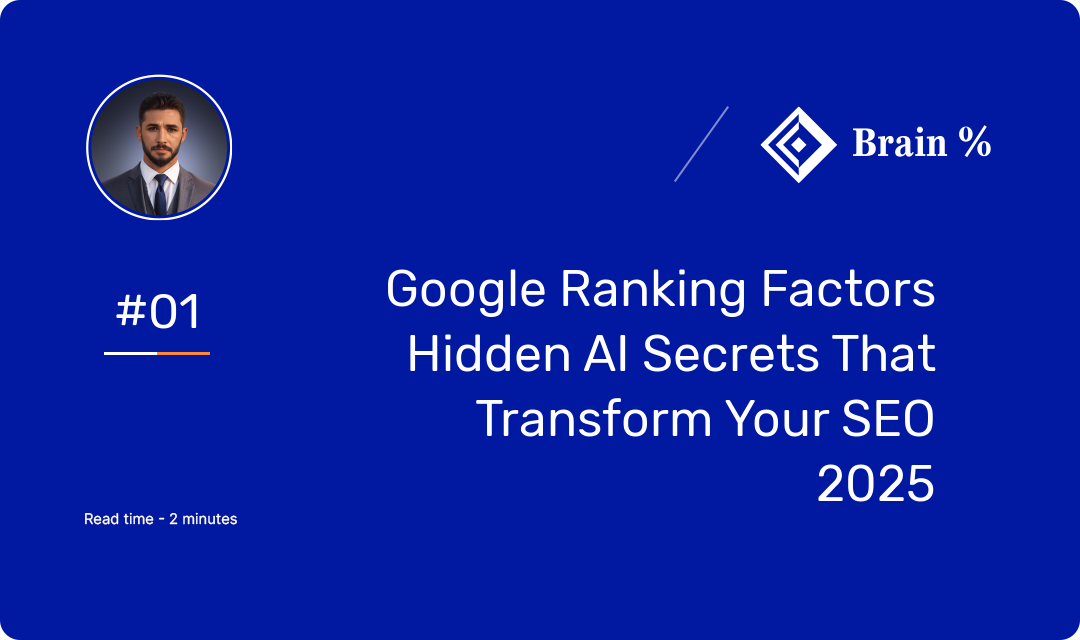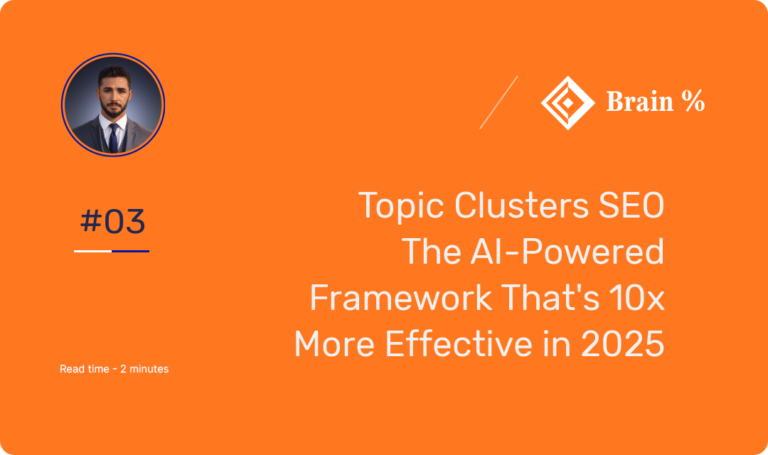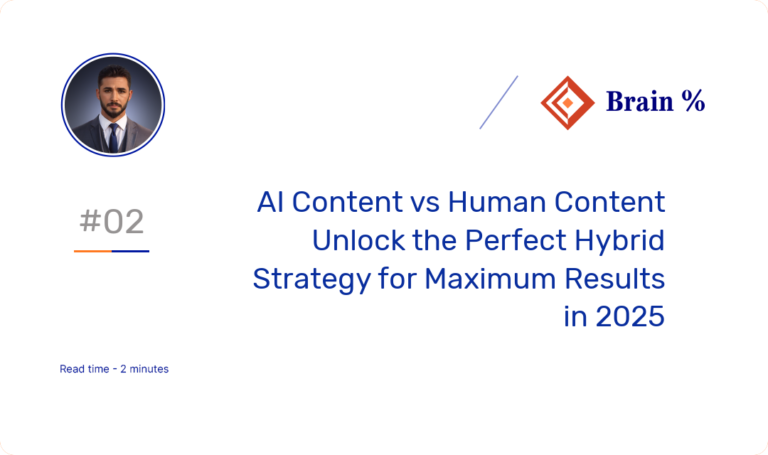Overcoming Digital Scale Paralysis: A Roadmap to AI-Powered Content Optimization
In today’s rapidly evolving digital landscape, mid-sized technology companies face an unprecedented challenge known as digital scale paralysis. This phenomenon occurs when organizations struggle to maintain consistent content quality while attempting to scale their digital presence. The pressure to produce high-volume, SEO-optimized content often leads to diminished quality and team burnout.
Marketing directors and their teams frequently encounter common roadblocks in content creation:
• Maintaining consistent brand voice across multiple channels
• Balancing content quality with production speed
• Managing resource allocation efficiently
• Keeping up with evolving SEO requirements
• Coordinating between content teams and SEO specialists
The traditional approach of adding more writers or utilizing basic AI tools has proven insufficient, creating a gap between content demands and delivery capabilities. These challenges are particularly acute when attempting to maintain consistent brand voice across multiple channels while optimizing for search engine algorithms.
However… advanced AI content optimization solutions are transforming how businesses approach these scaling challenges. By leveraging sophisticated artificial intelligence technologies, companies can now automate routine content tasks while maintaining high-quality standards and SEO optimization. This hybrid approach combines the efficiency of AI with human strategic oversight, enabling marketing teams to focus on higher-value activities while ensuring consistent content output.
The key to overcoming digital scale paralysis lies in implementing smart, scalable solutions that align with both immediate content needs and long-term SEO strategy. Through strategic deployment of AI-powered tools, organizations can maintain their competitive edge in search rankings while delivering valuable content that resonates with their target audience.
Understanding Google Ranking Factors: What Matters Most in 2024

In today’s rapidly evolving digital landscape, Google ranking factors have become increasingly sophisticated, incorporating advanced AI algorithms to determine website positioning. The search engine’s core ranking signals now heavily emphasize user experience metrics and content quality, moving beyond traditional SEO parameters.
E-E-A-T (Experience, Expertise, Authoritativeness, and Trustworthiness) has emerged as a CRITICAL foundation for content evaluation, particularly in sectors dealing with sensitive information or high-stakes decisions.
Key components of E-E-A-T include:
• Demonstrated field expertise through qualifications and credentials
• Consistent publishing of accurate, well-researched content
• Verifiable author profiles and expertise
• Regular content updates and fact-checking
• Strong industry authority signals and references
Core Web Vitals continue to play a pivotal role in Google’s ranking algorithm, focusing on loading performance, interactivity, and visual stability. These technical metrics, combined with mobile responsiveness and secure connections, form the backbone of modern SEO optimization strategies.
The impact on AI-generated content presents both opportunities and challenges, as Google’s sophisticated algorithms can now better distinguish between high-quality, purposeful content and mass-produced material. Implementation strategies must focus on creating value-driven content that demonstrates genuine expertise while maintaining technical excellence in website performance.
AI-Driven Content Optimization: Practical Tools and Strategies
When evaluating AI content tools for your SEO strategy, it’s crucial to focus on solutions that align with your specific business objectives and content workflows. Modern optimization strategies require a careful balance between artificial intelligence capabilities and human oversight to maintain authentic, high-quality output. Leading platforms like ContentScale AI and OptiWrite Pro have demonstrated remarkable success in enhancing search engine visibility while preserving brand voice.
Key components of effective AI content tools:
• Real-time SEO analysis and optimization suggestions
• Natural language processing capabilities
• Content performance tracking metrics
• Brand voice customization features
• Integration with existing content management systems
Integration methods for these tools demand a structured approach, beginning with a comprehensive analysis of your existing content creation process. Marketing teams must establish clear guidelines for AI implementation, ensuring seamless collaboration between human editors and machine learning algorithms. This hybrid approach has proven particularly effective in optimizing technical SEO elements while maintaining natural language patterns that Google’s ranking factors favor.
Consider the case of Jennifer’s Tech Company, which transformed their digital marketing analytics through strategic AI integration.
By implementing advanced content optimization tools, they achieved a 156% increase in organic traffic within six months. Their success came from carefully balancing automated content suggestions with expert human refinement, creating a sustainable model for content scaling that maintains quality standards.
Essential workflow steps for AI tool implementation:
- Audit existing content creation processes
- Define clear AI implementation guidelines
- Establish quality control checkpoints
- Monitor content performance metrics
- Adjust AI parameters based on results
The key to maximizing these tools lies in developing systematic workflows that complement your existing SEO optimization strategies. Regular monitoring and adjustment of AI parameters ensure that content consistently meets both search engine algorithms and user experience requirements, driving sustainable growth in search rankings.
Technical SEO Essentials for Business Technology and Wealth Industries

In today’s digital landscape, mastering technical SEO fundamentals becomes increasingly critical for businesses in the technology and wealth management sectors. Site speed and performance metrics directly impact both search engine rankings and user experience, making them essential Google ranking factors for 2025.
Core Web Vitals and structured data implementation require particular attention in these industries, where complex platforms and data-heavy applications are common.
Key technical metrics include:
• Largest Contentful Paint (LCP) for loading performance
• First Input Delay (FID) for interactivity
• Cumulative Layout Shift (CLS) for visual stability
• HTTPS security implementation
• Mobile-first indexing compliance
Industry-specific optimization demands a tailored approach to technical SEO, especially for wealth management and technology service providers. Implementation of schema markup for financial products and technical specifications becomes crucial for enhanced search visibility and featured snippet opportunities. AI platform requirements add another layer of complexity to technical SEO strategies.
Modern search engine algorithms now evaluate:
• Site architecture and navigation structure
• Mobile responsiveness across devices
• API integration capabilities
• Advanced crawling protocols
• Indexing efficiency metrics
By focusing on these technical SEO essentials, organizations can build a robust foundation for their digital presence that aligns with Google’s evolving ranking criteria. This strategic approach ensures better search engine visibility while catering to the sophisticated needs of technology and wealth industry clients.
Measuring ROI: Evaluating Content Quality and SEO Performance
In today’s data-driven landscape, tracking the return on investment (ROI) of your SEO efforts is crucial for optimizing Google ranking factors effectively. Modern performance tracking tools like Google Analytics 4 and SEMrush provide comprehensive insights into content performance and search visibility metrics.
Leading organizations leverage sophisticated ROI measurement methods to quantify the impact of their SEO strategies.
These approaches combine:
• Organic traffic and conversion rates
• User engagement patterns and behavior signals
• Content quality scores
• Technical SEO performance metrics
• Search visibility and ranking positions
A compelling example of successful SEO ROI tracking comes from JPMorgan’s digital transformation initiative. By implementing AI-powered content analytics and performance monitoring systems, they achieved a 156% increase in organic search visibility within 12 months. Their systematic approach to measuring content quality and tracking key performance indicators established a clear correlation between SEO optimization strategies and business outcomes.
The key to meaningful ROI evaluation lies in aligning content metrics with specific business objectives. This involves monitoring technical SEO parameters, analyzing user behavior signals, and tracking search engine algorithm updates to maintain optimal website ranking factors.
Through consistent performance tracking and data analysis, organizations can fine-tune their digital marketing analytics approach and maximize their return on SEO investments. This systematic evaluation ensures resources are allocated effectively while maintaining competitive edge in search rankings.
Optimizing Core Web Vitals for User Experience and Search Visibility
Core Web Vitals have become increasingly crucial Google ranking factors, directly impacting how search engines evaluate your website’s performance and user experience.
These metrics encompass three essential aspects:
• Loading Performance (LCP – Largest Contentful Paint)
• Interactivity (FID – First Input Delay)
• Visual Stability (CLS – Cumulative Layout Shift)
Optimizing page speed requires a comprehensive approach that includes minimizing server response times and implementing efficient caching strategies. Modern image formats and lazy loading techniques can significantly reduce initial load times, while proper resource prioritization ensures critical content displays quickly for users. Visual stability, measured through Cumulative Layout Shift (CLS), plays a vital role in maintaining user engagement and reducing bounce rates.
To achieve better stability scores, focus on:
• Setting proper image dimensions and aspect ratios
• Reserving space for dynamic content elements
• Optimizing font loading and delivery
• Minimizing layout shifts from advertisements
• Implementing stable banner and popup positions
User experience factors extend beyond technical metrics to include intuitive navigation, mobile responsiveness, and clear content hierarchy. These elements work together with Core Web Vitals to create a seamless browsing experience that search engines increasingly favor in their ranking algorithms.
The implementation of these optimization strategies requires careful monitoring through tools like Google Search Console and PageSpeed Insights. Regular assessment and adjustment of these website ranking factors ensure continued compliance with evolving search engine algorithms and maintain optimal search visibility.
Conclusion: Moving Toward Automated Excellence
As we navigate the evolving landscape of Google ranking factors, the integration of AI automation emerges as a cornerstone of successful SEO strategies. The digital transformation of search optimization demands a sophisticated approach that combines technical expertise with innovative thinking.
The convergence of traditional SEO practices and artificial intelligence creates unprecedented opportunities for businesses to enhance their search engine visibility. By leveraging AI-powered content optimization tools and advanced analytics, organizations can develop more precise, data-driven strategies that align with Google’s evolving algorithms.
Key components for successful AI-driven SEO implementation:
• Integration of AI-powered content optimization tools with traditional SEO practices
• Development of data-driven strategies based on advanced analytics
• Balance between automated processes and human oversight
• Focus on authentic, high-quality content creation
• Regular evaluation and adjustment of SEO processes
Looking ahead, successful implementation requires a balanced approach between automation and human oversight. Marketing teams should focus on developing comprehensive content strategies that incorporate both technical SEO elements and high-quality, audience-centric content creation. The key lies in maintaining authenticity while leveraging AI capabilities to scale operations efficiently.
For marketing directors and SEO professionals seeking to advance their digital presence, the next steps involve carefully evaluating existing processes and identifying opportunities for AI integration. Resources such as Google’s official guidelines, industry-leading SEO platforms, and professional AI consulting services can provide valuable guidance in this transformation journey toward automated excellence in search engine optimization.
Q&A
What are the most important Google ranking factors in 2024?
Google’s key ranking factors now include E-E-A-T (Experience, Expertise, Authoritativeness, and Trustworthiness), Core Web Vitals, mobile responsiveness, and content quality. Technical SEO elements like site speed, security (HTTPS), and user experience metrics are also crucial for search visibility.
How does AI impact Google’s ranking algorithm?
Google’s algorithms now use sophisticated AI to evaluate content quality, authenticity, and relevance. While AI-generated content is acceptable, it must demonstrate genuine expertise, provide value to users, and maintain high-quality standards to rank well in search results.
What role do Core Web Vitals play in SEO rankings?
Core Web Vitals are essential ranking signals that measure user experience through three main metrics: Largest Contentful Paint (loading performance), First Input Delay (interactivity), and Cumulative Layout Shift (visual stability). Strong performance in these areas positively influences search rankings.
How can businesses measure their SEO ROI effectively?
SEO ROI can be measured by tracking key metrics including organic traffic growth, conversion rates, user engagement patterns, content quality scores, and search visibility positions. Modern analytics tools like Google Analytics 4 and SEMrush provide comprehensive insights for evaluating SEO performance.
What is E-E-A-T and why is it important for SEO?
E-E-A-T (Experience, Expertise, Authoritativeness, and Trustworthiness) is a critical ranking factor that evaluates content quality and credibility. It encompasses demonstrated field expertise, accurate content publication, verifiable author credentials, and strong industry authority signals, particularly important for sectors dealing with sensitive information.






 עברית
עברית